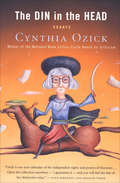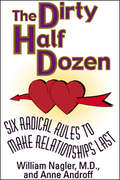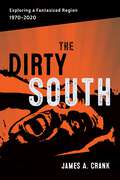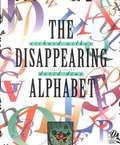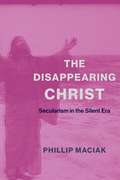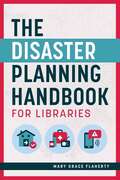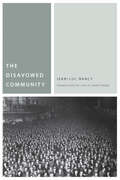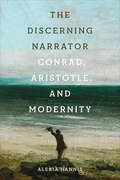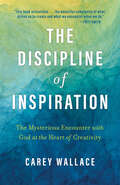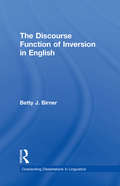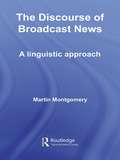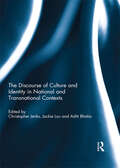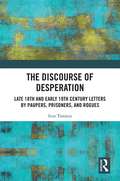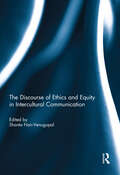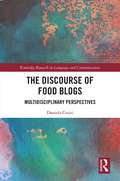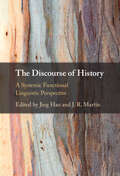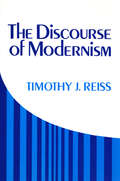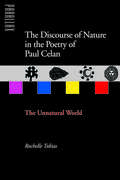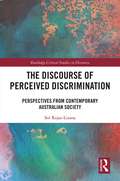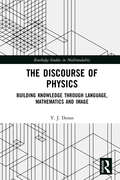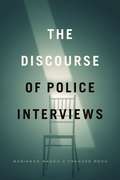- Table View
- List View
The Din in the Head: Essays
by Cynthia OzickA collection of essays on the joys of great literature from the New York Times–bestselling author and winner of the National Book Critics Circle Award. One of America&’s foremost novelists and critics, Cynthia Ozick has won praise and provoked debate for taking on challenging literary, historical, and moral issues. Her new collection of spirited essays focuses on the essential joys of great literature, with particular emphasis on the novel. With razor-sharp wit and an inspiring joie de vivre, she investigates unexpected byways in the works of Leo Tolstoy, Saul Bellow, Helen Keller, Isaac Babel, Sylvia Plath, Susan Sontag, and others. In a posthumous and hilariously harassing &“(Unfortunate) Interview with Henry James,&” Ozick&’s hero is shocked by a lady reporter. In &“Highbrow Blues,&” and in reflections on her own early fiction, she writes intimately of &“the din in our heads, that relentless inner hum,&” and the curative power of literary imagination. The Din in the Head is sure to please fans of Ozick, win her new readers, and excite critical controversy and acclaim. &“Open the collection anywhere—I guarantee it—and you will feel the bite of her distinctive voice.&” —Sven Birkerts, Los Angeles Times &“The passion that fills these essays is invigorating. In our age of irony and commercial pandering, we need writers like Ozick.&” —Danielle Chapman, Chicago Tribune
The Dinosaur Alphabet Book (Jerry Pallotta's Alphabet Books)
by Jerry PallottaThe perfect way to introduce children to the fascinating world of dinosaurs. Full of interesting facts--did you know some dinosaurs had sharp front teeth while others had no front teeth at all? This alphabet book explores both the known and the not-so-well known dinosaurs.Meet the heterodontosaurus (one of the smallest known to exist), the megalosaurus (the first dinosaur ever discovered), the iguanodon, the ultrasaurus, and more!Once again, Jerry Pallotta and Ralph Masiello have combined their talents to create a unique children's book that will inform and entertain young readers.
The Dirty Half Dozen: Six Radical Rules to Make Relationships Last
by Anne Androff William NaglerSay goodbye to conventional wisdom and say hello to "The Dirty Half Dozen." Here is a fresh, iconoclastic set of rules for improving your relationship dramatically.<P>Based on thirty years of psychiatric literature, including over 1,000 studies on relationships, as well as the author's own personal relationship experience, this book shows how satisfying, long-term relationships are not about abstract concepts like romance, honesty, or intimacy. They are about something far more simple. <P>Learn the value of the little white lie, the destructive potential of the "petty" differences, the myth of the perfect relationship, the care and feeding of the happy, lasting relationship within tension-free surroundings, and other secrets that every couple needs to know.
The Dirty South: Exploring a Fantasized Region, 1970–2020 (Southern Literary Studies)
by James A. CrankThe Dirty South examines the shifting significances of the South as a constructed, fantasized region in the American psyche, particularly its frequent association with tropes of dirt that emphasize soil, garbage, trash, grit, litter, mud, swamp water, slime, and pollution. Beginning with iconic works from the 1970s such as Deliverance and The Texas Chainsaw Massacre, James A. Crank traces the image of a “dirty” South into the twenty-first century to explore the social, political, and psychological effects of the region’s hold on the imaginations of southerners and nonsoutherners alike.With a focus on media forms through which southern identity gets articulated and questioned—including horror movies, Swamp Thing comics, and popular music by artists such as Waylon Jennings and OutKast—The Dirty South probes the sustained fascination with southern dirtiness while reflecting on its causes and consequences since the end of the civil rights era. Highlighting the period from 1970 to 2020, during which the South began to represent several new possible identities for the nation as a whole and for the area itself, Crank considers the ways that southerners have used depictions of dirt to create and police boundaries and to contest those boundaries. Each chapter pairs prominent literary or cultural texts from the 1970s with more contemporary works, such as Jordan Peele’s film Get Out, which recycle similar investments or, critically, challenge the inherent whiteness of the earlier images.By historicizing fantasies of the region and connecting them to the first decades of the twenty-first century, The Dirty South reveals that notions about southern dirtiness proliferate not because they lend authenticity or relevancy to the U.S. South, but because they aid so conspicuously in the zombified work of tethering investors (real and imagined) to a graveyard of ideas.
The Disappearing Alphabet
by Richard WilburPulitzer Prize-winning poet Richard Wilbur turns his sharp eye to the noble alphabet and imagines what life would be like without these twenty-six little--but powerful--letters. Packed with humor and witty subtleties, the verse in this captivating picture book is splendidly matched by Caldecott Medal winner David Diaz's hilariously clever illustrations.
The Disappearing Christ: Secularism in the Silent Era
by Phil MaciakAt the turn of the twentieth century, American popular culture was booming with opportunities to see Jesus Christ. From the modernized eyewitness gospel of Ben-Hur to the widely circulated passion play films of Edison, Lumière, and Pathé; from D. W. Griffith’s conjuration of a spectral white savior in Birth of a Nation to W. E. B. Du Bois’s “Black Christ” story cycle, Jesus was constantly and inventively visualized across media, and especially in the new medium of film. Why, in an era traditionally defined by the triumph of secular ideologies and institutions, were so many artists rushing to film Christ’s miracles and use his story and image to contextualize their experiences of modernity?In The Disappearing Christ, Phillip Maciak examines filmic depictions of Jesus to argue that cinema developed as a model technology of secularism, training viewers for belief in a secular age. Negotiating between the magic trick and the documentary image, the conflicting impulses of faith and skepticism, the emerging aesthetic of film in this period visualized the fraught process of secularization. Cinematic depictions of an appearing and disappearing Christ became a powerful vehicle for Americans to navigate a rapidly modernizing society. Studying these films alongside a multimedia, interdisciplinary archive of novels, photographs, illustrations, and works of theology, travel writing, and historiography, The Disappearing Christ offers a new narrative of American cultural history at the intersection of cinema studies and religious studies.
The Disaster Planning Handbook For Libraries
by Mary Grace FlahertyLibraries are in a unique position to aid communities during times of adversity, and this comprehensive handbook’s practical tools and expert guidance will help ensure that your library is thoroughly prepared for emergency response and recovery. Your library is a vital information hub and resource provider every single day, and that’s doubly true when calamity strikes. In fact, your library’s role as an “essential community function” during disasters is now encoded in U.S. law. Engaging as a partner in planning and preparedness will build much-needed community support should disaster strike, and even a basic plan will also save you time and stress later on. No matter where your library is in the disaster planning cycle, this handbook will make the process clearer and less daunting. You’ll get tools, activities, easy-to-adapt templates, and hands-on guidance on such topics as the six phases of disaster response; 15 first-hand accounts of library disaster planning or responses, helping you identify the library services most needed during a disaster; three essential factors that will shape the form of your disaster plan; preparing for hurricanes, tornadoes, fires, floods, and earthquakes; ideas for connecting with your community’s emergency response teams; federal government planning resources; pointers on working with state and local governments; a sample Memorandum of Understanding to outline mutual support for a speedier recovery; recommended courses and training, many of which are free; targeted advice for archives and special collections; sample building inspection checklists; and recommended games to help children and families prepare.
The Disavowed Community (Commonalities)
by Jean-Luc NancyOver thirty years after Maurice Blanchot writes The Unavowable Community (1983)—a book that offered a critical response to an early essay by Jean-Luc Nancy on “the inoperative community”—Nancy responds in turn with The Disavowed Community. Stemming from Jean-Christophe Bailly’s initial proposal to think community in terms of “number” or the “numerous,” and unfolding as a close reading of Blanchot’s text, Nancy’s new book addresses a range of themes and motifs that mark both his proximity to and distance from Blanchot’s thinking, from Bataille’s “community of lovers” to the relation between community, communitarianism, and being-in-common; to Marguerite Duras, to the Eucharist. A key rethinking of politics and the political, this exchange opens up a new understanding of community played out as a question of avowal.
The Discarded Image: An Introduction to Medieval and Renaissance Literature
by C. S. LewisIn The Discarded Image, C.S. Lewis paints a lucid picture of the medieval world view, providing the historical and cultural background to the literature of the Middle Ages and Renaissance. It describes the "image" discarded by later years as "the medieval synthesis itself, the whole organization of their theology, science and history into a single, complex, harmonious mental model of the universe." This, Lewis's last book, has been hailed as "the final memorial to the work of a great scholar and teacher and a wise and noble mind."
The Discerning Narrator: Conrad, Aristotle, and Modernity
by Alexia HannisThe Discerning Narrator sheds new light on Joseph Conrad’s controversial critique of modernity and modernization by reading his work through an Aristotelian lens. The book proposes that we need Aristotle – a key figure in Conrad’s education – to recognize the profound significance of Conrad’s artistic vision. Offering Aristotelian analyses of Conrad’s letters, essays, and four works of fiction, Alexia Hannis illuminates the philosophical roots and literary implications of Conrad’s critique of modernity. Hannis turns to Aristotle’s ethical formulations to trace what she calls "the discerning narrator" in Conrad’s oeuvre: a compassionate yet sceptical guide to appraising character and conduct. The book engages with past and current Conrad scholarship while drawing from Aristotle’s Poetics, Politics, and Nicomachean Ethics to offer original philosophical analyses of Conrad’s works. Drawing on Aristotle, Hannis provides a fresh context for making sense of Conrad’s self-differentiation from modernity. As a result, The Discerning Narrator provides an affirmation of literature’s invitation to wonder about the possibilities inherent in human nature, including the potential for painful depravity, heroic excellence, and ordinary human happiness.
The Discipline of Inspiration: The Mysterious Encounter with God at the Heart of Creativity
by Carey WallaceLearn where inspiration comes from and how to harness it in your life and work. We all know the sensation of inspiration. It&’s what tells a painter what to paint and a singer how to sing—and what prompts us to throw a new spice into an old recipe. But what is inspiration? When we train artists, we typically identify them by their talent and train them in technique. We talk very little about the crucial creative spark of inspiration. Where does it come from? What does it want from us? How can we get more of it? In The Discipline of Inspiration, Carey Wallace meditates on this vital spark and on the ways artists have negotiated with it across genres and throughout history. She also offers practical methods—including silence, community, and rest—to help everyone access more inspiration, more often. Artists will develop a fresh perspective on inspiration and learn new tools for their creative practice. And readers from all walks of life will discover the transformative power of inspiration in every aspect of their lives.
The Discourse Function of Inversion in English (Outstanding Dissertations in Linguistics)
by Betty BirnerFirst published in 1997. Routledge is an imprint of Taylor & Francis, an informa company.
The Discourse Strategies of Imperialist Writing: The German Colonial Idea and Africa, 1848-1945 (Routledge Critical Studies in Discourse)
by Felicity RashIn this monograph, Felicity Rash examines German colonialist texts through the lens of linguistics, using multiple analytic approaches in order to contribute to the study of ideological discourse. Focusing on texts from Germany’s colonial period during the Second Reich, the book describes the discourse strategies employed in a wide variety of colonialist discourses, from propagandistic and journalistic writing to autobiographical and fictional accounts of life in Germany's African colonies. The methodologies Rash employs include the Discourse Historical Approach and Cognitive Metaphor Theory, and the book aims to develop a new model for the analysis of expansionist nationalist writing. Little detailed analysis exists of the types of texts taken as primary sources, and Rash provides English translations of German quotations, in addition to drawing upon her research in former German colonies in Africa. Rash’s research will be of interest to linguists, historians, Germanists, and social and political scientists, and lays the groundwork for future interdisciplinary analyses of German colonialism.
The Discourse of Broadcast News: A Linguistic Approach
by Martin MontgomeryIn this timely and important study Martin Montgomery unpicks the inside workings of what must still be considered the dominant news medium: broadcast news. Drawing principally on linguistics, but multidisciplinary in its scope, The Discourse of Broadcast News demonstrates that news programmes are as much about showing as telling, as much about ordinary bystanders as about experts, and as much about personal testimony as calling politicians to account. Using close analysis of the discourse of television and radio news, the book reveals how important conventions for presenting news are changing, with significant consequences for the ways audiences understand its truthfulness. Fully illustrated with examples and including detailed examination of the high profile case of ex-BBC journalist Andrew Gilligan, The Discourse of Broadcast News provides a comprehensive study which will challenge our current assumptions about the news. The Discourse of Broadcast News will be a key resource for anyone researching the news, whether they be students of language and linguistics, media studies or communication studies.
The Discourse of Culture and Identity in National and Transnational Contexts
by Christopher J. Jenks, Jackie Lou and Aditi BhatiaThis collection examines and uses discourse to promote a better understanding of culture and identity, with the primary goal of advancing an understanding of how discourse can be used to examine social and linguistic issues. Many of the contributions explore how the formation of culture and identity is shaped by national and transnational issues, such as migration, immigration, technology, and language policy. The collection contributes to a better understanding of the process of intercultural communication research, as each author takes a different theoretical or methodological approach to examining discourse. Although different aspects of discourse are analyzed in this collection, each contribution examines issues and concepts that are central to understanding and carrying out intercultural communication research (e.g., structure and agency, static and dynamic cultural constructs, sociolinguistic scales, power and discourse, othering and alienness, native and non-native). This book was originally published as a special issue of Language and Intercultural Communication.
The Discourse of Desperation: Late 18th and Early 19th Century Letters by Paupers, Prisoners, and Rogues (Routledge Studies in Linguistics)
by Ivor TimmisThis book discusses how the poor and desperate in the late eighteenth and early nineteenth centuries mobilised their linguistic resources in pursuit of vital pragmatic goals, drawing on three corpora of letters written by the poor. The main question addressed by the book is, ‘How were the poor, often armed only with low levels of education and literacy, able to meet the challenge of writing letters vital to their interests, even to their survival?’ Timmis argues that the answer lies in the highly strategic approach adopted by the writers, particularly evident in the way formulaic language is used in the pauper and prisoner letters. Formulaic language supports the writers in producing intelligible letters in what they consider an appropriate tone but also allows them to exploit popular cultural motifs of the time. Data is drawn from three sources: pauper letters by the poor applying for parish relief, from around 1795 to 1834; prisoner letters by women awaiting deportation to Australia for defrauding the Bank of England in the early nineteenth century; and anonymous letters by the poor demanding money with menaces. Comparison with the Mayhew Corpus of interviews with the London poor in the 1850s reinforces the idea that part of the writers’ approach was to orient away from the vernacular towards a style they perceived to be more elevated. Showing how resourceful people can be in communicating their needs in crises and in turn surfacing new insights into literacy and demotic language awareness, this book will be of interest to students and scholars in corpus linguistics and social history.
The Discourse of Ethics and Equity in Intercultural Communication
by Shanta Nair-VenugopalThis book examines the notions of ethics and equity in relation to language and communication in intercultural relations. Although these notions are often discussed, they are not always addressed with regard to specifi c subjects. Much intercultural discourse and dialogue in recent times has been coloured by the clash of civilizations (as described by Samuel Huntington), terrorist attacks such as 9/11, and the indelible effects which these events have had on dealings between different peoples, cultures and religions. This book discusses ethics and equity with regard to marginalized and privileged minorities, victims of abuse and of confl ict, researchers and practitioners, and language learners and speaker/users. It opens up spaces for a critical discourse of ethics and equity in language and intercultural communication as ‘new’ knowledge. This book was originally published as a special issue of Language and Intercultural Communication.
The Discourse of Food Blogs: Multidisciplinary Perspectives (Routledge Research in Language and Communication)
by Daniela CesiriThis volume adopts a multidisciplinary perspective in analyzing and understanding the rich communicative resources and dynamics at work in digital communication about food. Drawing on data from a small corpus of food blogs, the book implements a range of theoretical frameworks and methodological approaches to unpack the complexity of food blogs as a genre of computer-mediated communication. This wide-ranging framework allows for food blogs’ many layered components, including recipes, photographs, narration in posts, and social media tie-ins, to be unpacked and understood at the structural, visual, verbal, and discourse level in a unified way. The book seeks to provide a comprehensive account of this popular and growing genre and contribute to our understandings of digital communication more generally, making this key reading for students and scholars in computer-mediated communication, multimodality, critical discourse analysis, corpus linguistics, and pragmatics.
The Discourse of History: A Systemic Functional Linguistic Perspective
by J. R. Martin Jing HaoTaking a Systemic Functional Linguistic perspective, this book explores how language builds our knowledge about the past and gives value to historical events, thereby shaping contemporary culture. It brings together cutting-edge research from an international team of scholars to provide a detailed study of texts from three different world languages (English, Spanish, and Mandarin Chinese) – revealing how the discourse of history is constructed in these languages. Each chapter provides examples and step-by-step analyses of how knowledge and value are constructed in history texts, drawing on Systemic Functional Linguistics to develop theory and description in relation to text analysis. It also makes connections with disciplinary literacy and history education, showing how linguistic findings can benefit the teaching and learning of historical literacy. Providing theoretical and analytical foundations for studies of the discourse of history, it is essential reading for anyone interested in literacy, discourse analysis, and language description.
The Discourse of Modernism
by Timothy J. ReissTimothy J. Reiss perceives a new mode of discourse emerging in early seventeenth-century Europe; he believes that this form of thought, still our own, may itself soon be giving way. In The Discourse of Modernism, Reiss sets up a theoretical model to describe the process by which one dominant class of discourse is replaced by another. He seeks to demonstrate that each new mode does not constitute a radical break from the past but in fact develops directly from its predecessor.
The Discourse of Nature in the Poetry of Paul Celan: The Unnatural World (Parallax: Re-visions of Culture and Society)
by Rochelle TobiasPaul Celan has long been regarded as the most important European poet after 1945 but also the most difficult owing to the numerous references in his work to his personal history and to a cultural heritage spanning many disciplines, centuries, and languages. In this insightful study, Rochelle Tobias goes a long way to dispelling the obscurity that has surrounded the poet and his work. She shows that the enigmatic images in his poetry have a common source. They are drawn from the disciplines of geology, astrology, and physiology or what could be called the sciences of the earth, the heavens, and the human being. Celan’s poetry borrows from each of these disciplines to create a poetic universe—a universe that attests to what is no longer and projects what is not yet.This is the unnatural world of Celan's poetry. It is a world in which time itself takes physical form or is made plastic. Through a series of close readings and philosophical explorations, Tobias reflects on the experience of time encoded and embodied in Celan's work. She demonstrates that the physical world in his poetry ultimately serves as a showcase for time, which is the most elusive aspect of human experience because it is based nowhere but in the mind. Tobias's probing interpretations present a new model for understanding Celan's work from the early elegiac poems to the later cryptic texts.An interdisciplinary project, the study combines readings of Celan's poetry with discussions of ancient and modern science, mystical cosmology, and twentieth-century literature and thought. Tobias's original approach to Celan illuminates his complex verse and contributes significantly to the theory of metaphor as it applies to modern verse.
The Discourse of Perceived Discrimination: Perspectives from Contemporary Australian Society (Routledge Critical Studies in Discourse)
by Sol Rojas-LizanaThis book offers a way forward toward a better understanding of perceived discrimination from a critical discourse studies perspective. The volume begins with a discussion of quantitative studies on perceived discrimination across a range of disciplines and moves toward outlining the ways in which a discourse-based framework, drawing on tools from cognitive linguistics and discursive psychology, offers valuable tools with which to document and analyze perceived discrimination through myriad lenses. Rojas-Lizana provides a systematic account, grounded in a critical approach, of perceived discrimination drawing on data from discourse from two minority groups, self-identified members of an LGBTIQ community and Spanish-speaking immigrants in Australia, and explores such topics as the relationship between language and discrimination, the conditions for determining what constitutes discriminatory acts, and both the copying and resistance strategies victims employ in their experiences. A concluding chapter offers a broader comparison of the conclusions drawn from both communities and discusses their implications for further research on perceived discrimination. This volume will be of particular interest to students and scholars in critical discourse studies, social policy, gender and sexuality studies, and migration studies.
The Discourse of Physics: Building Knowledge through Language, Mathematics and Image (Routledge Studies in Multimodality)
by Y. J. DoranThis book provides a detailed model of both the discourse and knowledge of physics and offers insights toward developing pedagogy that improves how physics is taught and learned. Building on a rich history of applying a Systemic Functional Linguistics approach to scientific discourse, the book uses an SFL framework, here extended to encompass the more recently developed Systemic Functional Multimodal Discourse Analysis approach, to explore the field’s multimodal nature and offer detailed descriptions of three of its key semiotic resources – language, image, and mathematics. To complement the book’s SFL underpinnings, Doran draws on the sociological framework of Legitimation Code Theory, which offers tools for understanding the principles of how knowledge is developed and valued, to explore the manifestation of knowledge in physics specifically and its relationship with discourse. Through its detailed descriptions of the key semiotic resources and its analysis of the knowledge structure of physics, this book is an invaluable resource for graduate students and researchers in multimodality, discourse analysis, educational linguistics, and science education.
The Discourse of Police Interviews
by Marianne Mason Frances RockForensic linguistics, or the study of language and the law, is a growing field of scholarly and public interest with an established research presence. The Discourse of Police Interviews aims to further the discussion by analyzing how police interviews are constructed and used to investigate and prosecute crimes. The first book to focus exclusively on the discourses of police interviewing, The Discourse of Police Interviews examines leading debates, approaches, and topics in contemporary police interview research. Among other topics, the book explores the sociolegal, psychological, and discursive framework of popular police interview techniques employed in the United States and the United Kingdom, such as PEACE and Reid, and the discursive practices of institutional representatives like police officers and interpreters that can influence the construction and quality of linguistic evidence. Together, the contributions situate the police interview as part of a complex, and multistage, criminal justice process. The book will be of interest to both scholars and practitioners in a variety of fields, such as linguistic anthropology, interpreting studies, criminology, law, and sociology.
The Discourse of Police Interviews
by Marianne Mason Frances RockForensic linguistics, or the study of language and the law, is a growing field of scholarly and public interest with an established research presence. The Discourse of Police Interviews aims to further the discussion by analyzing how police interviews are constructed and used to investigate and prosecute crimes. The first book to focus exclusively on the discourses of police interviewing, The Discourse of Police Interviews examines leading debates, approaches, and topics in contemporary police interview research. Among other topics, the book explores the sociolegal, psychological, and discursive framework of popular police interview techniques employed in the United States and the United Kingdom, such as PEACE and Reid, and the discursive practices of institutional representatives like police officers and interpreters that can influence the construction and quality of linguistic evidence. Together, the contributions situate the police interview as part of a complex, and multistage, criminal justice process. The book will be of interest to both scholars and practitioners in a variety of fields, such as linguistic anthropology, interpreting studies, criminology, law, and sociology.
